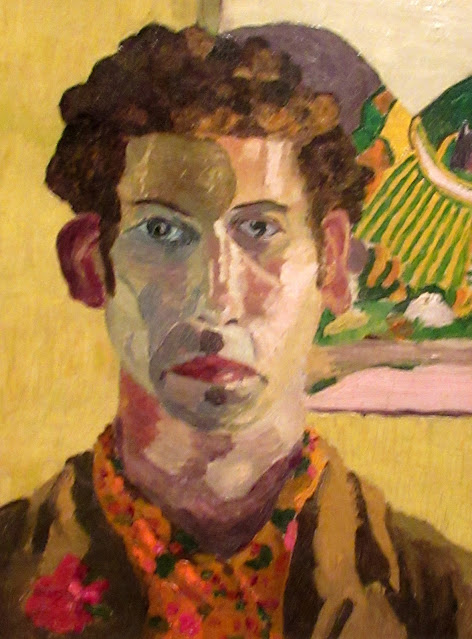The Art of the Selfie
at the National Museum, Cardiff.
When the Musee d'Orsay approached the Cardiff Museum wanting to borrow La Parisienne by Renoir, the Museum were reluctant at first. La Parisienne has been in the Welsh collection since 1952 when it was bequeathed by the Welsh patron of the arts and Impressionist collector Gwendoline Davies and is one of their prized exhibits. In the end it was agreed that the Musee d'Orsay would reciprocate by sending Portrait of the Artist by Van Gogh which is now the centrepiece of an exhibition that poses the question: 'Is a self-portrait the original selfie?'
The exhibition looks at self-portraits the explores just some of the watys that artists have presented a face to the world. From the 1600s to the present day, these works reveal not just how artists see themselves, but also how they wish to be seen. Self-portraits are about much more than physical appearance. They are a way for artists to explore identity, a means of self-reflection or self-interrogation. They can tell us not just what the artist looked like, but about their life, environment, and even their state of mind.
Portrait of the Artist, 1887, (oil on canvas)
This is one of around twenty self-portraits Van Gogh painted while living in Paris between 1886 and 1888. There, his painting style changed radically, combining the influence of Impressionism, Japanese prints and the science of colour theory.
As a struggling artist, Van Gogh couldn't afford to pay for models so he used a mirror. He uses complementary colours - blues and oranges, reds and greens - in long brushstrokes which converge at the centre of the canvas to form his distinctive features. Each of Van Gogh's many self-portraits is different. They give us insight beyond the popular myths surrounding him. The portraits reveal a focused and diligent artist, ambitious and hopeful for his painting in spite of the mental health challenges he faced.
Anya Paintsil, Blod, 2022, (acrylic, wool, synthetic hair, alpaca, mohair and human hair on hessian)
David Jones, Human Being, 1931, (oil on canvas)
Paul Mpagi Sepuya, Studio, 2020, (archival pigment print)
The mirror is usually an invisible presence in self-portraiture. It becomes visible in the constructed images of Sepuya. This solidarity print was created by the artist as a fundraising effort in the wake of the Black Lives Matter protests following the murder of George Floyd in 2020. Proceeds from sales went to organisations in America that fight for Black lives and queer lives.
Angus McBean, Self-Portrait, (silver gelatin print)
The artist superimposes himself against his own silhouette, creating a dual self-portrait.
Bedwyr Williams, Bard Attitude, 2005, (C-type print on dibond)
Brenda Chamberlain, Self Portrait, 1936, (oil on canvas)
Francis Bacon, Study for Self-Portrait, 1963, (oil on canvas)
Bacon approached his portraits as an expressive response to the human form. He challenged the idea that portraiture should offer a direct likeness, aiming instead to capture the essence of his sitters. He painted himself many times. In later life these became expressions of grief and loss.
Cedric Morris, Self-portrait, 1919, (oil on canvas)
Shani Rhys James, Direct Gaze I, 1997, (oil on linen)
Edgar Holloway, Self Portrait, 1932, (etching on paper)
Holloway was a self-taught artist. He learned his etching technique by studying the work of both Rembrandt and Augustus John. Like these artists, he used self-portraiture to explore aspects of his personality.
Augustus John, Self-Portrait: Tete Farouche, 1906, (etching on paper)
Rembrandt Harmeneszoon Van Rijn, Self Portrait in a Velvet Cap and Plume, with Embroidered Dress, 1648, (etching on paper)
Edna Clarke Hall, Self Portrait as a Girl, 1899/1900 Self Portrait, 1920 (crayon on paper)
Here are two interpretations of the artist's face: one in youth, the other with experience of life's complexity. Clarke Hall was a prodigy who went to the Slade School of Art aged just fifteen. Her hopes of a career were ended by marriage at the age of 19. She continued to draw but struggled to reconcile her self-identity as an artist with the expectations of marriage and motherhood. Only after suffering a breakdown in the early 1920s was she able to reclaim this identity.

















Interesting. I liked your comments on Van Gogh. Brenda Chamberlain's portrait is quite moving. Would be nice if I can get to see this exhibition before it closes. Need to get a job soon!!
ReplyDeleteThank you, Liam. I really enjoyed seeing the exhibition - mind you, Cardiff Museum has never disappointed. Good luck on the job hunt, I am sure it will all go well.
Delete